Treatments can be classified as nourishing / stoutening or as slimming. Dvividha Upakramaneeya will focus on two primary types of Ayurveda treatment. The 14th Chapter in Ashtanga Hrudaya Sutrasthana is called Dvividha Upakramaneeya Adhyaya. Dvividha means 2 types. Upakrama means treatment. Let’s explore it further.
Dvividha Upakarma – two forms of therapy :
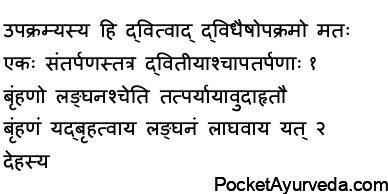
Dvividha Upakarma
In order is treated the human body is two kinds namely obese and lean, treatment also comes in two types.
1. Santarpana– nourishing, enriching. It’s also known as Brihmana (Stoutening and gaining weight, causing heaviness)
2. Apartarpana -depleting, cleansing. It’s also known as Langhana (fasting and losing weight, gaining lightness, etc.). 1-2

In general, Brimhana treatment is dominant in conjunction with Prithvi (Earth element) and Ap (water element).
Langhana is predominant with the three elements (Fire air, ether, and air).Shadvidha Upakrama

Functions like Snehana (olation professional lubrication) along with Rukshana (oleation/lubrication) and Rukshana (imparting the sensation of dryness), Swedana– (sweating therapy and diaphoresis), Sthambhana– (withholding or blocking)
They are also of two varieties: Brihmana in addition to Langhana.
Snehana and Sthambhana can be classified by Brahmana as well.
Rukshana and Swedana could be classified as Langhana
Therefore, all functions are separated by two .3-3 1/2
Langhana Therapy imparts an airy feel for the entire body. The body is made slim and lightweight. It comes in two varieties. Shodhana and shamana

Shodhana – Purification processes (Panchakarma) as well as Shamana palliative care. 4

Shodhana treatment eliminates imbalanced Doshas from the body with force. It comes in five varieties that are viz
Niruha- decoction enema,
Vamana – emesis, vomiting treatment Kaya Reka Virechana purgation of the body
Shio Reka Shiro Virechana – Nasya purgation of the head and nasal instillation of medicine. Asra-visruti Raktamokshana blood letting .5
Shamana – palliative treatment

Shamana-Palliative Treatment is one that does not eliminate the increased Doshas from the body. It doesn’t increase the normal Dosha but it does make the abnormal Doshas normal.
Shortly, Shamana treatment brings imbalanced Dosha to normal.
Shamana 7 types –
Pachana – digestive, carminatives, Deepana – hunger producing, stomachic,
Kshut in spite of eating disorders, avoidance of food and fasting
Trut– overcoming thirst/avoiding drinking water, Vyayama – physical exercise,
Aatapa – exposure to the sun and
Maruta the exposure of the breeze. 6-6 1/2
Brimhana Chikitsa – Nourishing therapy

Brimhana Chikitsa The treatment of nourishment also is Shamana solely because it relieves and reduces Vata as well as Vata Pitta- combination.
Chikitsa Classification

Patients who require nourishing therapy Brimhaneeya Persons requiring Nourishing therapy – Brimhaneeya

Brimhana The treatment for nutrition should be provided to people who are Vyadhi Karashita affected by the disease,
Bhaishajya Karshita Emaciated by treatments with medicines, Madya Karshita, emaciated due to alcohol Stri Karshita, emaciated from excessive sexual activities Shoka Karshita – Emaciated due to sadness,
Bhara – who transports large loads frequently
Adhva – the person who has walked/traveled over a considerable distance Urakshata – person who has suffered chest injuries KShatakseena who is severely handicapped due to an injury Ruksha – who suffers from excessive dryness
Durbala – debilitated Vatala – A person with Vata form of body. Garbhini – pregnant
Sutika is the woman who given birth, Bala – children, Vruddha – the old and
Greeshme is a good choice in the summer time and even those who aren’t listed above should receive A nourishing treatment.
Method of Brihmana – through the use of milk, meat, sugar, ghee, in a sneeze prepared with sweet ingredients and fats(oil, Ghee) Sleep, a comfy bed, oil massages, bath relaxation as well as peace and joy in the head.
8-9 1/2
Patients who require treatment for thinning – Langhaneeya
Persons requiring thinning therapy – Langhaneeya

Langana-thinning treatment for slimming must be applied to Meha or diabetes.
Amadosha is a condition that affects people suffering from Ama
Atisnigdha – who has had to undergo excessive oleation treatment (Before snehana) Jvara – fever Urustambha – stiffness in the thighs, Kushta – skin disorders
Visarpa – herpes, Vidhradi– abscess,
Pleeha – spleen diseases, Shira, Kanta Akshi roga head, throat, and eyes;
Sthula – Those who are obese
In addition to other people even during Shishira Winter, Langhana treatment should be performed. 10-11
Indications for Langhana treatment with Shodhana – Panchakarma
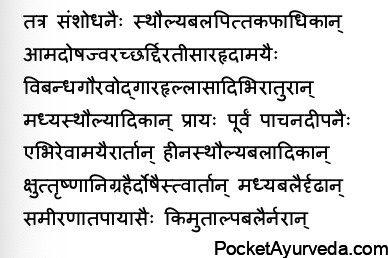
Indication for Langhana therapy by means of Shodhana (Panchakarma)
Patients suffering from these conditions need to be treated with Panchakarma as a means of Langhana treatment.
The most vulnerable are those who are heavy, overweight, and with the predominance of Pitta and Kapha sufferers of Amadosha, vomiting, fever, Diarrhoea, hearts diseases, constipation, feelings of weight, excessive vomiting, nausea, and so on.
The indication for Deepana, Pachana, and then Shodhana Panchakarma
The obese who are moderately or have a moderately strong body, and suffer from the illnesses mentioned earlier, initially with the use of digestives or food-producing substances in general followed by other treatments for purification.
Indications for Shamana kind of Langhana Indication for Shamana type of Langhana
People who suffer from more Doshas, are moderately strong or have moderate strength diseases and are able to withstand stress through the control of thirst and hunger; also have weak strength of the body as well as illness by exposure to the sun, breeze, and exercising. 12- 14 1/2
Brimhana and langhana therapy

Patients who are scheduled to receive Langhana- a thinning therapy shouldn’t be given Brimhana- stoutening.
Those who will be receiving Brimhana should receive mild Langhana and/or the combination of Langhana and Brimhana in combination, at the same time, can be administered based on the type of habitat the season, the strength, etc. 15
The benefits of Brimhana therapy

Benefits of Brimhana therapy
Brimhana therapy helps to increase endurance, nutrition for the body, and also cures diseases that are treatable with that treatment. 16
Benefits of Langhana Therapy
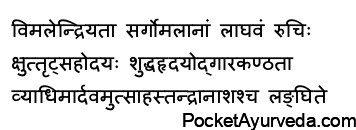
Benefits of Langhana Therapy
Clarity and sensitivity of the organs that sense, the expulsion of Malas, Doshas and wastes A feeling of lightness in the body, Good taste perception, Appears to be thirsty and hungry combined, A feeling of pureness in the chest (heart) Belching without a trace and a clear throat.
The disease is softerless severe, with the improvement of enthusiasm, and Loss of stupor – laziness 16-17

The treatments that are used to treat these conditions can excessive amounts than are necessary can lead to severe obesity and emaciation which will be listed in the near future, as well as their treatment.18

Ati Brimhana – over Nourishing Therapy :
Ati Brimhana- excess of Nourishing therapy
The excess of Brimhana therapy causes Atisthaulya, a massive weight gain Apachi – – scrofula
Meha – Diabetes, UTI Jvara – fever
Udara – abdominal enlargement,
Bhagandara – fistula-in-ano,
Kasa – cough
Sanyasa, loss of consciousness,
Mutrakruchra – Dysuria,
Ama– disorders of weak digestion, Kushta -skin diseases which are extremely dreadful. 20
Treatment for over-nourishing or excessive Brimhana

Treatment for over nourishing – Excess Brimhana
Treatment for obesity in Ayureda
Treatments that reduce Meda as fat, Anila – Vata as well as Kapha are recommended; use of Kulattha horse gram Dolichos Biflorus Jurna, Shyamaka,
Yava – Barley – Hordeum Vulgare, Mudga – Green Gram – Averrhoa Carambola and Honey water;
Indulgence in worry, stressful activities
Treatments for purification, avoiding sleeping,
Triphala, Guduci, Abhaya -(Chebulic Myrobalan fruit rind – Terminalia Chebula) or Musta (Cyperus thetus) is recommended to lick daily with honey;
It could be Rasanjana (Aqueous Extract of Berberis Aristata), Brihat Pancamula (Agnimantha, Shyonaka, Gambhari, Patala, Bilva), Guggulu together with the Juice of Agnimnatha is good;
A powder made that contains Vidanga (False Black Pepper (Embelia has ribs), Nagara – (Ginger), Kshara– Yavakshara and iron filing, or the powder from Yava (Barley Hordeum vulgare) and Amla, as well as honey, must be licked regularly. 21-24
Ritucharya adhyaya ऋतुचर्या Seasonal Regimen : Ashtanga Hridayam Chapter 3
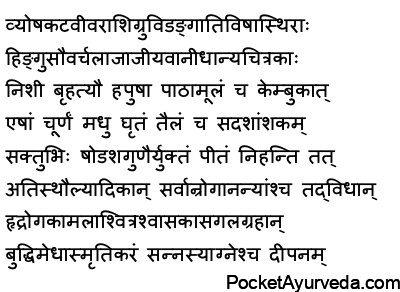
The powder from Vyosha (also known as (Trikatu – Shunthi, Maricha,Pippali), Katvi, Vara (Triphala), Shigru (drum stick), Vidanga (False black pepper embelia Ribes), Ativisha, Sthira (Desmodium Gangeticum), Hingu – (Asa foetida), Sauvarcala, Ajaji – (Cuminum Cyminum), Yavani – (Trachyspermum ammi), Dhanya, Chitraka, the two Nisa (turmeric and tree turmeric) and the two Brihati (brihati and Kantakari), Hapusa, the root of Patha (Cyclea peltata) and Kebuka, which should be combined together with honey, Ghee, and oil in a proportion equal to sixteen percent of saktu (corn flour)
This mixture cures the diseases mentioned earlier, and other diseases of a similar nature, like heart disease, jaundice, Leucoderma, Dyspnoea, obstruction in the throat, hoarseness of voice, etc. Improves the quality of thought ability, memory, and intelligence and ignites the weakened digestion by fire. 25-28
Ati langhana Lakshana – excess of thinning therapy:
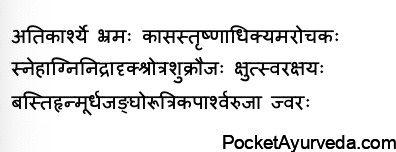

Ati langhana Lakshana- excess of thinning therapy:-
Profound emaciation,
Bhrama – Delusion, Dizziness,
Kasa – cough
Trushna – intense thirst
Aruchi – anorexia
loss of moisture, decrease in water content, and digestion power, as well as sleep loss, vision, hearing the semen Ojas appetite, and vocal
Urinary bladder pain in the heart, head calves, thighs upper and lower flanks,
The symptoms include fever, delirium–excess of talking, vomiting, fatigue, vomiting bleeding pain in the bones and joints; the non-elimination of urine, faeces, and so on. are the result of an excess of Langhana 29-30

Emaciation is more easy to cure than obesity,
however, there is no cure for the overweight, as neither Brimhana nor Langhana can eliminate the excess stomach fat, digestive activity, and Vata. 31

Emaciation is treated with the help of sweet and unctuous– food items and a healthy lifestyle while obesity is cured through the use of food items, that have different qualities from the previous when utilized in large amounts. Foods, liquids, and medications that are Brimhana are recommended to be consumed 32-33

The obese person is made to look like a boar due to being free of worries, the joy of it, by more intake of healthy food, and sleeping. 34

There is no other meat to strengthen the body, especially carnivores’ meat because they eat meat. 35
Heavy and non nourishing diet for obesity

Foods that are heavy and not nutritious are perfect for those who are overweight and the reverses are suitable for the thin (Light and Nutritious).
Yava Barley – Barley Hordeum vulgare – barley weighs a lot and is not nutritious, which makes it ideal for overweight people.
Godhuma wheat is light to digest and nutrient-rich. which is why it is a good choice for those who are emaciated. 36

Although the types of Doshas are numerous and endless, as are the types of treatments, such as Grahi and withholding however they don’t outdo the two types of Brimhana and Langhana similar to the ailments, though numerous can be classified into two distinct types that are innumerable, fall into two categories, namely Sama or Nirama. (with as well as without Ama)
This chapter is titled Dvividhopakrmaniyathe fourteenth chapter of Sutrasthana of Astanga Hrudaya.
FAQ’s of Dvividhopakramaniya Adhyaya
What is Dwividha Upakrama?
Two fold treatment : Santarpana/Bhrimhana and Apatarpana/Langhana
what are the types of shodhana karma?
Niruha,Vamana,Virechana,Nasya,Raktamokshana
what are the types of shamana chikitsa?
Pachana,Deepana,Kshut,Trut,Vyayama,Aatapa,Maruta
how to do bhrimhana therapy?
milk,meat,sugar,ghee,sweets,fats,sleep,oil massage,bath,relaxation,peace,joy
what are the indications of fasting langhana?
Obese, Diabetes, Ama Dosha, Atisnigdha,Jvara,Urustambha,Kustha,Visarpa, Vidhradi,Pleeha,Head throat and eyes diseases.shishira season
what are the indications of brimhana nourishing therapy?
Vyadhi Karashita, Bhaishajya Karshita,Stri Karshita,Shoka Karshita,Bhara,Adhva,Urakshata,KShatakseena,Durbala,Vatala,Garbhini,Sutika,Bala,
what are the benefits of brimhana therapy?
increase endurance, nutrition for the body, and also cures diseases that are treatable with that treatment.
what are the benefits of langhana therapy?
Clarity and sensitivity of the organs that sense, the expulsion of Malas, Doshas and wastes A feeling of lightness in the body, Good taste perception, Appears to be thirsty and hungry combined, A feeling of pureness in the chest (heart) Belching without a trace and a clear throat.
The disease is softerless severe, with the improvement of enthusiasm, and Loss of stupor – lazinessWhat is the Ati Brimhana Lakshana?
Atisthaulya, a massive weight gain, Apachi, Meha, Jvara,Udara, Bhagandara, Kasa, Sanyasa,Mutrakruchra,Ama
what is the Treatment for obesity in Ayureda?
Treatments that reduce Meda as fat, Anila – Vata as well as Kapha are recommended.,Kulattha horse gram,Shyamaka,Yava,Mudga,Honey water,Indulgence in worry, stressful activities,Treatments for purification, avoiding sleeping,Triphala, Guduci,Musta,Brihat Pancamula, Guggulu.
what are the symptoms of excessive fasting?
Profound emaciation,Bhrama,Kasa,Trushna,Aruchi,loss of moisture,sleep loss,decreased digestion power,fever, delirium–excess of talking, vomiting, fatigue, vomiting bleeding pain in the bones and joints; the non-elimination of urine, faeces, and so on. are the result of an excess of Langhana
what type of diet is advised for obesity as per ayurveda?
Heavy and non nourishing diet.


